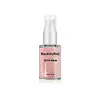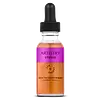What's inside
What's inside
 Key Ingredients
Key Ingredients

 Benefits
Benefits

 Concerns
Concerns

 Ingredients Side-by-side
Ingredients Side-by-side

Water
Skin ConditioningPropanediol
SolventPolysorbate 20
EmulsifyingTamarindus Indica Seed Polysaccharide
Skin ConditioningRhizobian Gum
Orobanche Rapum Extract
Skin ProtectingXylitylglucoside
HumectantAnhydroxylitol
HumectantXylitol
HumectantSodium Hyaluronate
HumectantSodium Benzotriazolyl Butylphenol Sulfonate
UV AbsorberAcrylates/C10-30 Alkyl Acrylate Crosspolymer
Emulsion StabilisingCalcium Aluminum Borosilicate
Titanium Dioxide
Cosmetic ColorantSilica
AbrasiveAmmonium Acryloyldimethyltaurate/Vp Copolymer
Sodium Hydroxide
BufferingPhenoxyethanol
PreservativeEthylhexylglycerin
Skin ConditioningParfum
MaskingIron Oxides
Tin Oxide
AbrasiveCI 17200
Cosmetic ColorantCI 19140
Cosmetic ColorantWater, Propanediol, Polysorbate 20, Tamarindus Indica Seed Polysaccharide, Rhizobian Gum, Orobanche Rapum Extract, Xylitylglucoside, Anhydroxylitol, Xylitol, Sodium Hyaluronate, Sodium Benzotriazolyl Butylphenol Sulfonate, Acrylates/C10-30 Alkyl Acrylate Crosspolymer, Calcium Aluminum Borosilicate, Titanium Dioxide, Silica, Ammonium Acryloyldimethyltaurate/Vp Copolymer, Sodium Hydroxide, Phenoxyethanol, Ethylhexylglycerin, Parfum, Iron Oxides, Tin Oxide, CI 17200, CI 19140
Water
Skin ConditioningGlycerin
HumectantButylene Glycol
HumectantPhenoxyethanol
PreservativePolysorbate 20
EmulsifyingTamarindus Indica Seed Polysaccharide
Skin ConditioningPropanediol
SolventXylitylglucoside
HumectantSodium Hyaluronate
HumectantAcrylates/C10-30 Alkyl Acrylate Crosspolymer
Emulsion StabilisingPentylene Glycol
Skin ConditioningAnhydroxylitol
HumectantEthylhexylglycerin
Skin ConditioningIsononyl Isononanoate
EmollientCaffeine
Skin ConditioningParfum
MaskingTetrasodium Glutamate Diacetate
Xylitol
HumectantMica
Cosmetic ColorantSodium Hydroxide
BufferingAmmonium Acryloyldimethyltaurate/Vp Copolymer
Sodium Benzotriazolyl Butylphenol Sulfonate
UV AbsorberTerminalia Ferdinandiana Fruit Extract
AntioxidantGlucose
HumectantSalvia Hispanica Seed Extract
EmollientCI 77491
Cosmetic ColorantMangifera Indica Fruit Extract
Skin ConditioningOrobanche Rapum Extract
Skin ProtectingCI 77891
Cosmetic ColorantRhizobian Gum
Sodium Citrate
BufferingCitric Acid
BufferingPotassium Sorbate
PreservativeSodium Benzoate
MaskingChlorphenesin
AntimicrobialCI 16035
Cosmetic ColorantCI 19140
Cosmetic ColorantLimonene
PerfumingHexyl Cinnamal
PerfumingBenzyl Salicylate
PerfumingLinalool
PerfumingCitronellol
PerfumingWater, Glycerin, Butylene Glycol, Phenoxyethanol, Polysorbate 20, Tamarindus Indica Seed Polysaccharide, Propanediol, Xylitylglucoside, Sodium Hyaluronate, Acrylates/C10-30 Alkyl Acrylate Crosspolymer, Pentylene Glycol, Anhydroxylitol, Ethylhexylglycerin, Isononyl Isononanoate, Caffeine, Parfum, Tetrasodium Glutamate Diacetate, Xylitol, Mica, Sodium Hydroxide, Ammonium Acryloyldimethyltaurate/Vp Copolymer, Sodium Benzotriazolyl Butylphenol Sulfonate, Terminalia Ferdinandiana Fruit Extract, Glucose, Salvia Hispanica Seed Extract, CI 77491, Mangifera Indica Fruit Extract, Orobanche Rapum Extract, CI 77891, Rhizobian Gum, Sodium Citrate, Citric Acid, Potassium Sorbate, Sodium Benzoate, Chlorphenesin, CI 16035, CI 19140, Limonene, Hexyl Cinnamal, Benzyl Salicylate, Linalool, Citronellol
Ingredients Explained
These ingredients are found in both products.
Ingredients higher up in an ingredient list are typically present in a larger amount.
Acrylates/C10-30 Alkyl Acrylate Crosspolymer is a synthetic polymer. It is used to thicken and improve the texture of products. Due to its properties, it can prevent water and oil ingredients from separating.
Ammonium Acryloyldimethyltaurate/Vp Copolymer (let's call it AAVC for short) is a synthetically created polymer. It's used as a film-forming agent and used to thicken the consistency of products.
AAVC is able to increase the consistency and viscosity of products due to its large molecule size. It also prevents ingredients from separating.
This ingredient is created from dehydrating xylitol in acidic conditions. Xylitol is a famous sugar and humectant.
Much like its predecessor, anhydroxylitol is a humectant. Humectants attract and hold water to moisturize the skin.
This ingredient is most commonly found in a popular trio called Aquaxyl. Aquaxyl is made up of anhydroxylitol (24 - 34%), xylitylglucoside (35 - 50%), and xylitol (5 - 15%).
According to a manufacturer, Aquaxyl is known for a 3-D hydration concept and an anti-dehydration shield to reinforce the outer layer of skin.
This ingredient is often derived from plants such as wood and sugarcane.
Learn more about AnhydroxylitolCI 19140 is also known as Tartrazine. Tartrazine is a synthetic dye used in cosmetics, foods, and medicine to add a yellow color.
Tartrazine is created from petroleum and is water-soluble.
Some people may experience allergies from this dye, especially asthmatics and those with an aspirin intolerance.
Learn more about CI 19140Ethylhexylglycerin (we can't pronounce this either) is commonly used as a preservative and skin softener. It is derived from glyceryl.
You might see Ethylhexylglycerin often paired with other preservatives such as phenoxyethanol. Ethylhexylglycerin has been found to increase the effectiveness of these other preservatives.
We don't have a description for Orobanche Rapum Extract yet.
Parfum is a catch-all term for an ingredient or more that is used to give a scent to products.
Also called "fragrance", this ingredient can be a blend of hundreds of chemicals or plant oils. This means every product with "fragrance" or "parfum" in the ingredients list is a different mixture.
For instance, Habanolide is a proprietary trade name for a specific aroma chemical. When used as a fragrance ingredient in cosmetics, most aroma chemicals fall under the broad labeling category of “FRAGRANCE” or “PARFUM” according to EU and US regulations.
The term 'parfum' or 'fragrance' is not regulated in many countries. In many cases, it is up to the brand to define this term.
For instance, many brands choose to label themselves as "fragrance-free" because they are not using synthetic fragrances. However, their products may still contain ingredients such as essential oils that are considered a fragrance by INCI standards.
One example is Calendula flower extract. Calendula is an essential oil that still imparts a scent or 'fragrance'.
Depending on the blend, the ingredients in the mixture can cause allergies and sensitivities on the skin. Some ingredients that are known EU allergens include linalool and citronellol.
Parfum can also be used to mask or cover an unpleasant scent.
The bottom line is: not all fragrances/parfum/ingredients are created equally. If you are worried about fragrances, we recommend taking a closer look at an ingredient. And of course, we always recommend speaking with a professional.
Learn more about ParfumPhenoxyethanol is a preservative that has germicide, antimicrobial, and aromatic properties. Studies show that phenoxyethanol can prevent microbial growth. By itself, it has a scent that is similar to that of a rose.
It's often used in formulations along with Caprylyl Glycol to preserve the shelf life of products.
Polysorbate 20 is made by combining ethoxylation of sorbitan, ethylene oxide, and lauric acid. It is a mild cleansing agent, surfactant, and emulsifier.
As a surfactant, it helps collect dirt and oils for washing. Emulsifiers prevent oils and water from separating.
Polysorbate 20 also adds scent to a product. Since it is made using sorbitol, it has a sweet scent. Sorbitol can also be found in fruits such as apples and peaches.
The lauric acid used to create Polysorbate 20 is often derived from coconuts.
Polysorbate 20 may not be fungal acne safe.
Learn more about Polysorbate 20Propanediol is an all-star ingredient. It softens, hydrates, and smooths the skin.
It’s often used to:
Propanediol is not likely to cause sensitivity and considered safe to use. It is derived from corn or petroleum with a clear color and no scent.
Learn more about PropanediolWe don't have a description for Rhizobian Gum yet.
We don't have a description for Sodium Benzotriazolyl Butylphenol Sulfonate yet.
Sodium Hyaluronate is hyaluronic acid's salt form. It is commonly derived from the sodium salt of hyaluronic acid.
Like hyaluronic acid, it is great at holding water and acts as a humectant. This makes it a great skin hydrating ingredient.
Sodium Hyaluronate is naturally occurring in our bodies and is mostly found in eye fluid and joints.
These are some other common types of Hyaluronic Acid:
Learn more about Sodium HyaluronateSodium Hydroxide is also known as lye or caustic soda. It is used to adjust the pH of products; many ingredients require a specific pH to be effective.
In small amounts, sodium hydroxide is considered safe to use. However, large amounts may cause chemical burns due to its high alkaline.
Your skin has a natural pH and acid mantle. This acid mantle helps prevent harmful bacteria from breaking through. The acid mantle also helps keep your skin hydrated.
"Alkaline" refers to a high pH level. A low pH level would be considered acidic.
Learn more about Sodium HydroxideWe don't have a description for Tamarindus Indica Seed Polysaccharide yet.
Water. It's the most common cosmetic ingredient of all. You'll usually see it at the top of ingredient lists, meaning that it makes up the largest part of the product.
So why is it so popular? Water most often acts as a solvent - this means that it helps dissolve other ingredients into the formulation.
You'll also recognize water as that liquid we all need to stay alive. If you see this, drink a glass of water. Stay hydrated!
Learn more about WaterXylitol is a humectant and prebiotic. It can help with dry skin.
In studies, xylitol has been shown to improve dry skin. It decreased transepidermal water loss, or when water passes through the skin and evaporates. Xylitol also showed to help improve the biomechanical properties of the skin barrier.
The prebiotic property of xylitol may also help reinforce our skin's natural microbiome. Having a healthy microbiome prevents infection by bad bacteria and helps with hydration.
As a humectant, Xylitol helps draw moisture from both the air and from deeper skin layers. This helps keep skin hydrated.
Xylitol is a sugar alcohol and commonly used as a sugar substitute. It is naturally occurring in plants such as strawberries and pumpkin.
Learn more about XylitolXylitylglucoside is created from xylitol and glucose, two humectants.
Not surprisingly, this ingredient is also a humectant. It attracts and holds water in your skin, helping to maintain hydration.
This ingredient is most commonly found in a popular trio called Aquaxyl. Aquaxyl is made up of anhydroxylitol(24 - 34%), xylitylglucoside (35 - 50%), and xylitol (5 - 15%).
According to a manufacturer, Aquaxyl is known for a 3-D hydration concept and an anti-dehydration shield to reinforce the outer layer of skin.
Learn more about Xylitylglucoside